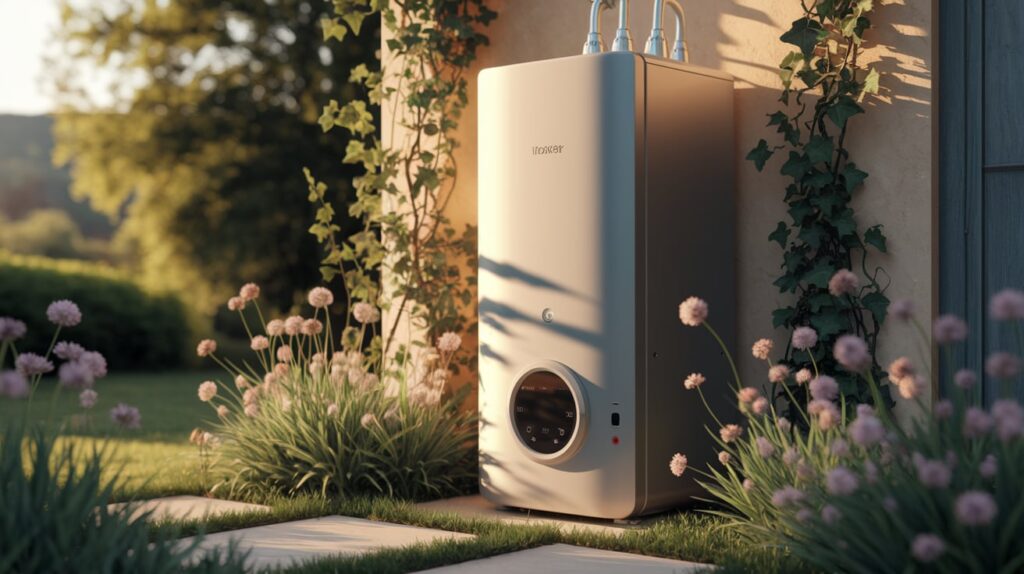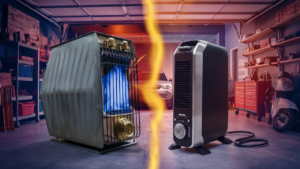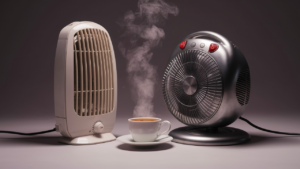Imagine stepping into a warm shower only to be greeted by icy water because your outdoor tankless water heater has succumbed to freezing temperatures. Frustrating, isn’t it?
You rely on your heater to provide hot water year-round, so the thought of it freezing is unsettling. But don’t worry. There are simple steps you can take to keep your outdoor tankless water heater from freezing. By following these strategies, you not only protect your investment but also ensure that you and your family continue to enjoy the comforts of hot water, even in the chilliest months.
So, how can you safeguard your heater against the cold? Let’s dive into practical tips that will keep it running smoothly and protect it from freezing. You’ll find peace of mind knowing you’re prepared for whatever winter throws your way.
Understanding Freezing Risks
Outdoor tankless water heaters face freezing risks during cold months. These risks can lead to significant damage. Understanding these risks is essential for prevention. Knowing how cold weather impacts your heater helps you take action. Let’s explore the reasons behind freezing.
Impact Of Cold Weather
Cold weather can cause your heater to freeze. Pipes and internal parts are at risk. Frozen water expands, damaging components. This can lead to costly repairs or replacements. Protecting your heater in winter is crucial.
Why Tankless Heaters Freeze
Tankless heaters freeze due to trapped water inside. Cold temperatures cause this water to solidify. Poor insulation increases the risk. Lack of proper drainage also contributes. Understanding these factors helps in prevention.
Choosing The Right Location
Selecting the ideal spot for your outdoor tankless water heater prevents freezing. Choose a sheltered location with wind protection. Ensure proper drainage to avoid water accumulation.
Choosing the right location for your outdoor tankless water heater is crucial to prevent it from freezing. A strategic spot can help maintain its efficiency and longevity, especially during harsh winter months. Whether you’re installing a new unit or moving an existing one, knowing where to place it can make all the difference.
Ideal Installation Spots
Think about the areas around your home that naturally offer some protection. Placing the heater near walls can shield it from direct exposure to the elements. The south side of your house might be a good choice because it typically receives more sunlight, which can help keep the unit warmer.
Consider installing the heater under an overhang or a porch. These locations can provide extra shelter and help maintain a stable temperature around the unit. Make sure there’s enough ventilation to avoid any safety hazards.
Avoiding Wind Exposure
Wind is a major culprit in causing tankless water heaters to freeze. It can rapidly decrease the temperature of the unit, making it more susceptible to freezing. So, how do you protect your heater from wind?
Place your heater away from prevailing winds. Observe the direction of the wind in your area and choose a location that naturally blocks it. Fences or natural barriers like bushes can also serve as windbreaks.
Consider investing in a windproof enclosure. These covers are designed to protect outdoor units from extreme weather conditions. They can be a small but worthwhile investment in ensuring your heater remains operational throughout winter.
Have you ever had an issue with your heater freezing? Reflect on where it’s placed and if it’s exposed to harsh winds. Could a simple change in location make a difference? Your tankless water heater’s placement is more than just a detail—it’s a key factor in keeping it running smoothly all year round.
Insulation Techniques
Keeping your outdoor tankless water heater from freezing can be a challenge during colder months. Insulation techniques are your best friend here. They offer a practical and affordable solution to protect your heater from the chill. You don’t want to end up with frozen pipes, do you? Let’s dive into some effective methods.
Using Pipe Insulation
Think of pipe insulation as a cozy jacket for your water heater pipes. It’s simple yet effective. You can use foam pipe insulation to wrap around exposed pipes. This material is easy to handle and install.
Measure the length of your pipes before buying insulation. This ensures you get the right amount without waste. Many hardware stores offer pre-slit foam tubes that fit snugly over your pipes.
Seal the ends with tape to keep the insulation secure. This prevents cold air from sneaking in through the gaps. If you’ve ever wrapped a gift, you’ve got the skills to wrap your pipes too.
Blankets For Heater Protection
Blankets aren’t just for keeping you warm during a movie night. They can protect your heater from freezing temperatures. Specialized heater blankets are available for this purpose.
These blankets are made from durable, weather-resistant materials. They can withstand the elements and provide insulation to keep your heater safe. They are designed to fit snugly around your tankless water heater.
Before you wrap your heater, make sure it’s clean and dry. A dirty surface can affect the blanket’s efficiency. Wouldn’t you want your heater to have the best protection possible?
Using these simple insulation techniques could save you from a costly repair. Which method will you try first to keep your outdoor tankless water heater from freezing this winter?
Proper Drainage
Proper drainage is crucial for your outdoor tankless water heater. It prevents freezing and costly repairs. Regularly draining your heater ensures it functions well during cold months. Neglecting this step can lead to damage. Follow these guidelines to protect your investment.
Importance Of Draining
Draining stops water from freezing in the heater. Frozen water can expand and crack pipes. This leads to leaks and expensive fixes. Regular drainage ensures smooth operation. It maintains efficiency and longevity. Protecting your heater from cold is essential.
Steps To Effective Drainage
Start by turning off the power supply. This prevents accidents while you work. Next, close the water inlet valve. This stops new water from entering the heater. Open the drain valve to let water flow out. Ensure all water is expelled. You can use a bucket to collect it.
Check for residual water in the pipes. Use a small tool to clear any blockages. Seal the drain valve tightly after draining. This prevents leaks when refilling. Inspect the heater for any damage. Regular checks keep your heater in top condition. Follow these steps to prevent freezing.
Temperature Monitoring
Monitoring the temperature of your outdoor tankless water heater is crucial. Cold weather can damage your heater. It might stop working altogether. Proper temperature checks ensure your heater stays safe and efficient. This section will guide you through installing thermostats and using remote sensors to keep your heater frost-free.
Installing Thermostats
Thermostats keep track of temperature changes. They help maintain optimal conditions for your heater. Install a thermostat near your water heater. This device will alert you if temperatures drop too low. Choose a thermostat that suits outdoor use. It should withstand harsh weather conditions. Regular checks ensure your thermostat is functioning well.
Using Remote Sensors
Remote sensors offer flexibility. They let you monitor the heater from a distance. Install sensors around your heater. Connect them to a smart device for updates. You can check temperatures even when you’re not home. This helps in taking quick action if temperatures fall. Remote sensors provide peace of mind during cold nights.

Heater Maintenance
Protect outdoor tankless water heaters from freezing by insulating pipes and using heat tape. Regularly check for leaks and ensure proper ventilation. Keep the unit clean to maintain efficient operation during cold weather.
Maintaining your outdoor tankless water heater is crucial to ensure it operates efficiently, especially during freezing temperatures. Regular maintenance can prevent unexpected breakdowns and costly repairs. By following a consistent maintenance schedule, you’ll keep your heater in top shape and avoid the stress of dealing with a frozen system.
Regular Inspections
Performing regular inspections of your heater can save you from a lot of headaches. Make it a habit to check your heater every few weeks, especially during winter. Look for visible signs of wear and tear or any unusual noises.
Check all connections and valves to ensure they’re secure. Loose connections can lead to leaks, which might freeze and cause significant damage. If you notice anything unusual, address it immediately rather than waiting for it to escalate.
Ask yourself: When was the last time I inspected my heater? If you can’t remember, it’s probably time for a check-up.
Cleaning And Servicing
Cleaning your outdoor tankless water heater is another essential maintenance task. Dust and debris can accumulate over time, affecting the unit’s efficiency. A clean heater operates smoothly and reduces the risk of freezing.
Begin by wiping down the exterior of your heater with a damp cloth. For the interior, refer to your heater’s manual to ensure you’re not damaging any components while cleaning.
Schedule a professional servicing at least once a year. Professionals can spot potential issues that you might overlook. They’ll also perform tasks like descaling, which is essential to maintain efficiency.
Have you ever thought about how a little bit of cleaning can make your heater last longer? Regular cleaning not only extends the life of your heater but also ensures it’s ready to withstand the coldest days.
Power Backup Solutions
Keeping your outdoor tankless water heater from freezing is crucial, especially during harsh winters. One effective way to ensure your heater remains operational is by having a reliable power backup solution. When temperatures drop, power outages can occur, leaving your heater vulnerable to freezing. By investing in power backups, you can ensure your heater stays functional, even in the coldest conditions. Here’s how you can utilize battery backups and solar power options to safeguard your heater.
Using Battery Backups
Battery backups can be a lifesaver for your outdoor tankless water heater. They provide a steady power supply, ensuring your heater continues to operate during power outages. You can opt for portable battery units that are easy to install and manage. Many homeowners find these backups invaluable, especially in areas prone to frequent power cuts.
Consider lithium-ion batteries for their efficiency and long lifespan. They’re compact and can be easily stored near your heater. You can even purchase units with smart technology that automatically kicks in during a power failure. This means you don’t have to manually switch your heater to battery power, saving you time and effort.
Have you ever thought about how much peace of mind a battery backup can provide? Knowing your heater won’t freeze when the power goes out can be a huge relief. It’s a simple, yet effective solution that can save you from costly repairs.
Solar Power Options
Solar power is an eco-friendly and sustainable backup choice for your heater. Installing solar panels not only helps in keeping your heater functional but also reduces your electricity bills. If you live in a sunny area, this might be the best option for you.
Solar panels can be installed on your roof or other areas with maximum sun exposure. They capture sunlight and convert it into electricity, powering your heater. You can store excess energy in solar batteries for use during cloudy days or at night.
Imagine harnessing the power of the sun to keep your heater operational. It’s a clean energy solution that aligns with modern environmental standards. Plus, it adds value to your property, making it an investment worth considering.
Have you ever wondered how much potential your roof holds in terms of energy production? Solar panels unlock this potential, providing you with a reliable power source. It’s a smart choice for those looking to combine efficiency with sustainability.
Choosing the right power backup solution can make all the difference during a cold snap. Whether you opt for battery backups or solar power, ensuring your heater stays operational is crucial for your comfort and peace of mind. What steps will you take to protect your heater from the cold?
Emergency Preparedness
Outdoor tankless water heaters face freezing risks in cold seasons. Emergency preparedness is essential. It ensures uninterrupted hot water supply. Readiness for unexpected freezes can prevent damage. It can also save costly repairs. Knowing how to handle freezing situations quickly is vital.
Quick Thawing Techniques
Quick thawing can prevent serious damage. Use a hairdryer to gently heat pipes. Warm towels can also help thaw frozen areas. Ensure water is off before starting any thawing methods. Don’t use open flames to thaw pipes. It can be dangerous and damage the heater.
When To Call A Professional
Sometimes DIY methods aren’t enough. If thawing techniques fail, call a professional. Professionals ensure safe thawing of frozen pipes. They can identify hidden issues causing freeze-ups. Regular maintenance checks help prevent future problems. It’s wise to call experts for complex issues.
Frequently Asked Questions
How To Keep An Exterior Tankless Water Heater From Freezing?
Insulate pipes and heater with foam covers or heat tape. Ensure proper drainage to prevent water buildup. Use freeze protection kits or thermostatic controls. Regularly check for leaks and maintain adequate clearance around the unit. Keep the heater powered for consistent function during cold weather.
Do Outdoor Tankless Water Heaters Need To Be Covered?
Outdoor tankless water heaters should be covered to protect them from harsh weather. A cover prevents damage from rain, snow, and debris. It extends the heater’s lifespan and maintains efficiency. Ensure proper ventilation when using a cover to avoid overheating.
Regularly check and maintain the cover for optimal protection.
How Do You Winterize An Outdoor Tankless Water Heater?
Drain the heater completely and disconnect the water supply. Insulate exposed pipes and use a tankless water heater cover. Ensure proper ventilation and install a freeze protection solenoid. Regularly check for leaks and maintain settings to prevent freezing.
How To Insulate A Tankless Water Heater Outside?
Insulate an outdoor tankless water heater using weather-resistant covers or thermal blankets. Ensure proper ventilation and access for maintenance. Use pipe insulation to protect exposed plumbing. Avoid blocking exhaust vents to maintain efficient operation. Regularly check insulation for wear and replace as needed.
Conclusion
Protecting your outdoor tankless water heater is essential during freezing months. Simple measures can prevent costly damages. Use insulation blankets to wrap your heater. They trap heat and guard against cold. Regular maintenance checks are crucial. Clean and inspect your heater frequently.
A proper vent system is vital too. It prevents cold air intrusion. Keep an eye on the weather forecasts. Sudden temperature drops require quick action. Shut off water supply if needed. Drain pipes to avoid freeze damage. Safeguard your heater, and it will last longer.
Stay proactive and enjoy uninterrupted hot water all winter.








